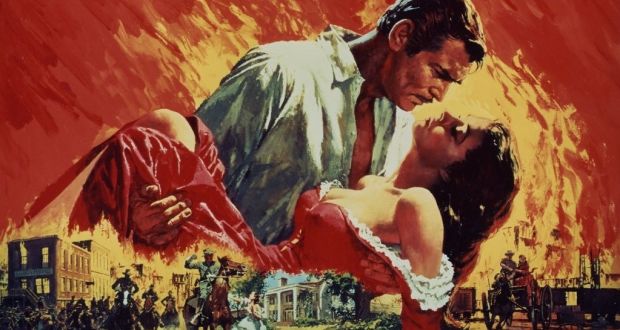(This is the newest chapter of a book-in-progress, “Television, and How It Got That Way.” For the full book (so far) in order, click “The Book” under “categories.”)
Ted Turner’s business philosophy – and maybe his life – can be summed up in one word: “more.”
That’s an approach that took him through big gambles, big movies (including “Gone With the Wind,” shown here) and big changes in the cable-TV world.
Turner had one cable channel (TBS) and wanted many more. “It’s all about shelf space,” he told the Television Critics Association.
More channels mean more places to sell ads and (eventually) more money in per-subscriber fees. The catch is that you have to fill those shelves with things people want. You need programs and a purpose.
That had been easy for TBS, which was simply an independent station that went national in 1979. It followed the pattern of other indie stations – reruns, movies and sports. (That last part worked well, because Turner also owned the Atlanta Braves and Hawks.) The station was especially popular in small towns and the South, so Andy Griffith was big; so was wrestling.
Meanwhile, Reese Schonfeld wrote in his CNN book, some indie-station people felt TBS should add something else:
“We thought it was time for Ted to start a news show in Atlanta. Ted said he never would. He had enough entertainment product to last forever. And beside that, he didn’t watch news; he hated news.”
And then, in 1979, he changed. As Schonfeld describes their meeting:
“Ted is frank. He still doesn’t want to do news, but he says it is the only form of programming left open to him. He would rather do sports, but ESPN has preempted that. He would rather do entertainment programming – sitcoms, dramas and quiz shows – but the networks own all that.”
From those modest motivations, CNN debuted in 1980 and gradually proved its worth. In key times – the Iraq war, 9/11, the first Trump term – it was vital. And in quieter times? Well, it obsessed approximately forever on a Malaysian airliner that was never found.
CNN could go on forever, restocking with news. But how could Turner fill other networks? Ever the gambler, he made two audacious moves; he:
— Agreed to buy MGM/United Artists in 1986, for a then-unheard-of $1.5 billion; and
— Bought the Hanna-Barbera and Ruby-Spears animation studios in 1991 for what ultimately was $415 million.
When the TCA asked him about his staggering debt load, Turner sort of shrugged “I think we’re OK,” he said, unconvincingly.
That turned out to be true. He got about half the $1.5 billion back by selling most of the MGM assets. That left him with what he really wanted – a library that included all the MGM films before 1986 and (due to previous deals MGM had made) everything from RKO and everything Warner Bros. made before 1950.
Looking at what he’d bought, Turner sounded like a kid rifling through his Christmas stocking.
He suddenly owned the favorite movie in his Atlanta home town, “Gone With the Wind.” He had “The Wizard of Oz,” “Casablanca” and “Citizen Kane.” He had Tarzan and Lassie and Andy Hardy and Pink Panther and lots of glitzy musicals and hard-boiled detectives. And, he proclaimed, he had all those Warner cartoons, “including Bugs Bunny.”
Turner’s enthusiasm over Bugs drew some laughter from the TCA, but it was valid. Some of Hollywood’s greatest animation moments came from the Looney Tunes days of Bugs Bunny, Road Runner and director Chuck Jones.
In his new treasure trove, Turner also had one of TV’s best moments, the Jones/Dr. Seuss collaboration on “How the Grinch Stole Christmas.”
And he had the rights to other Seuss books. An anti-war zealot, Turner waved “The Butter Battle Book” and proclaimed it (quite accurately) as one of the greatest books ever. Then he turned it into an animated TV special.
The next job was to convert all of that into new networks and fresh shelf space. Turner:
— Launched a second network, TNT, in 1988. He wanted to start with “Gone With the Wind,” but a previous deal gave CBS the rights for one more year; he swapped two extra airings of “The Wizard of Oz,” to get it back. This Atlanta-based network could start with the burning of Atlanta.
— Created The Cartoon Network in 1992, starting with all the ‘toons he owned. He had the Hanna-Barbera shows (the Flintstones and Jetsons and Smurfs, Yogi and Scooby and more), the Ruby-Spears ones (Alvin and Heathcliff and such) and Bugs and friends.
— Kept making new films for TNT (starting with Charlton Heston in “A Man For All Seasons”) and licensing others. Eventually, TNT didn’t need the older films. In 1994, they became the core of Turner Classic Movies.
Again, the debut film was “Gone With the Wind.” And again, a previous deal had to be undone: Turner had licensed many of his older films to American Movie Classics; now he had to pay to get them back.
That gave Turner five networks and vast shelf space. He had shown the immense potential of cable. Things were splendid … until deals intervened:
— In 1996, Turner merged with Time Warner (the Warner Bros. parent company) and became, as he put it, “the world’s richest employee.” He would donate much of his money to the United Nations and other causes.
— In 2001, Time Warner had a disastrous merger with AOL.
— In 2018, Time Warner sold to AT&T.
— And in 2022, the entire monolith was bought by the smaller Discovery networks.
The early deals diminished Turner’s role. And each deal left a new owner with fresh debts and reasons to economize.
The Turner networks – created through audacity, risks and big spending – kept trimming down. But at their peak, they had propelled a cable universe.
